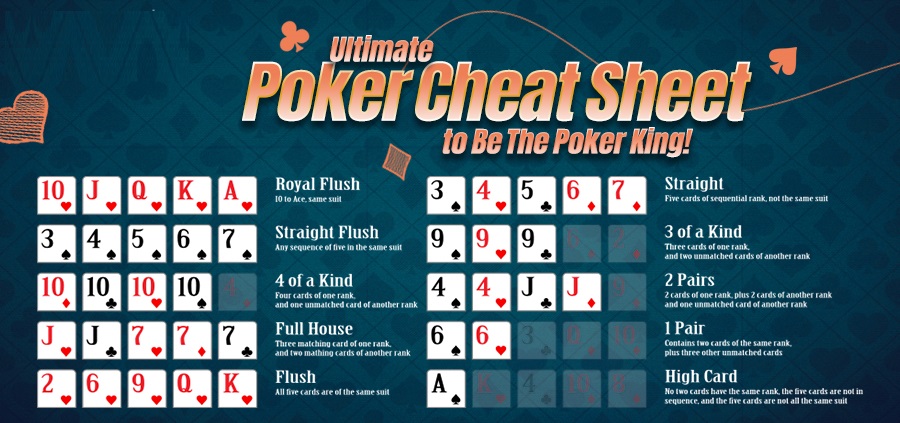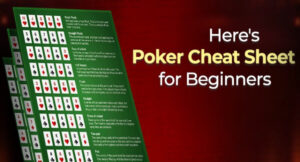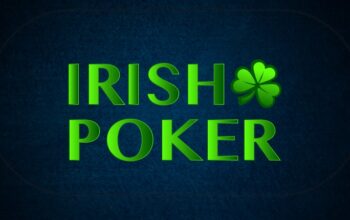
Table of Contents
ToggleIntroduction poker cheat sheet
Poker Cheat Sheet is a game of skill, strategy, and psychology that has captivated millions of players around the world. Whether you are a novice looking to learn the basics or an experienced player aiming to refine your skills, having a solid understanding of poker fundamentals is essential. One of the most valuable tools for any poker player is a poker cheat sheet—a concise reference guide that can help you make better decisions at the table. In this comprehensive article, we will delve into the essential components of a poker cheat sheet and provide detailed insights to help you master the game.
Understanding Poker Hand Rankings
The foundation of any poker cheat sheet is a clear understanding of hand rankings. These rankings determine the strength of your hand compared to your opponents’. Here are the standard poker cheat sheet hand rankings, from highest to lowest:
- Royal Flush: A, K, Q, J, 10, all of the same suit.
- Straight Flush: Five consecutive cards of the same suit (e.g., 9, 8, 7, 6, 5 of hearts).
- Four of a Kind: Four cards of the same rank (e.g., four aces).
- Full House: Three cards of one rank and two cards of another rank (e.g., three kings and two fives).
- Flush: Five cards of the same suit, not in sequence.
- Straight: Five consecutive cards of different suits.
- Three of a Kind: Three cards of the same rank.
- Two Pair: Two cards of one rank and two cards of another rank.
- One Pair: Two cards of the same rank.
- High Card: If no one has any of the above hands, the highest card wins.
Understanding these hand rankings is crucial because they form the basis of your decision-making process during a poker cheat sheet game.
Poker Starting Hands
Another vital component of a poker cheat sheet is guidance on starting hands. Your starting hand is the initial two cards dealt to you (in Texas Hold’em) or your first set of cards in other poker cheat sheet variants. Here are some key points to consider when evaluating your starting hand:
Premium Hands
- AA (Pocket Aces): The best starting hand in Texas Hold’em.
- KK (Pocket Kings): Second only to pocket aces.
- QQ (Pocket Queens): A strong hand that can dominate many opponents.
- AK (Ace-King, suited or unsuited): A powerful hand with potential to form high pairs, straights, and flushes.
Strong Hands
- JJ (Pocket Jacks): A strong hand but can be vulnerable to higher pairs and overcards.
- AQ (Ace-Queen, suited or unsuited): A solid hand with good potential.
- KQ (King-Queen, suited): Strong, especially suited, with good drawing possibilities.
Speculative Hands
- 10-10, 9-9, 8-8 (Pocket Tens, Nines, Eights): Medium pairs that can be valuable if the flop is favorable.
- AJ, KJ, QJ (Ace-Jack, King-Jack, Queen-Jack, suited or unsuited): Hands with potential but can be tricky to play.
- Suited Connectors (e.g., 9-10 of hearts): Hands with good potential for straights and flushes.
Weak Hands
- Low Pairs (e.g., 2-2 to 6-6): These can be difficult to play and are often folded unless you hit a set on the flop.
- Offsuit Hands with Low Kickers (e.g., 7-9 offsuit): These hands typically do not perform well and are often best folded.
Positional Play
Position is a critical concept in poker cheat sheet and should be a major consideration on your cheat sheet. Your position at the table can significantly influence your strategy and the strength of your hand. Here’s a breakdown of how to adjust your play based on position:
Early Position
Players in early positions (e.g., under the gun) act first and have less information about their opponents’ actions. As a result, you should play tighter and only enter the pot with strong hands.
Middle Position
In middle position, you have more information than early position players but less than those in late position. Here, you can widen your range slightly and play a mix of strong and speculative hands.
Late Position
Late position (e.g., the button and cutoff) offers the most strategic advantage, as you can see how many opponents act before you. In these positions, you can play a broader range of hands and be more aggressive with bluffs and semi-bluffs.
Blinds
The small blind and big blind positions are unique because you are forced to put money into the pot before seeing your cards. You should defend your blinds selectively and be cautious of overcommitting with weak hands.
Betting Strategy
 A well-rounded poker cheat sheet should include a section on betting strategy. Understanding when and how to bet can make a significant difference in your success at the table. Here are some key betting concepts:
A well-rounded poker cheat sheet should include a section on betting strategy. Understanding when and how to bet can make a significant difference in your success at the table. Here are some key betting concepts:
Value Betting
Value betting is when you bet with the intention of getting called by worse hands. This strategy is used when you believe you have the best hand and want to maximize your winnings.
Bluffing
Bluffing involves betting or raising with a weak hand to force your opponents to fold stronger hands. Effective bluffing requires a good understanding of your opponents’ tendencies and the ability to tell a convincing story.
Continuation Betting
A continuation bet (c-bet) is a bet made by the player who took the initiative in the previous betting round, typically the pre-flop raiser. This bet is used to maintain pressure on opponents and often forces them to fold weaker hands.
Check-Raising
Check-raising is a deceptive move where you check with the intention of raising if an opponent bets. This strategy can be used to build the pot with a strong hand or to bluff and represent strength.
Pot Control
Pot control involves keeping the pot size manageable when you have a marginal hand. This strategy can help you avoid losing large amounts of money when you’re unsure about the strength of your hand relative to your opponents’.
Reading Opponents
A crucial skill in poker cheat sheet is the ability to read your opponents and gain insights into their potential holdings and strategies. Your cheat sheet should remind you of key tells and patterns to watch for:
Physical Tells
- Nervousness: Shaking hands, rapid breathing, or fidgeting can indicate a weak hand.
- Confidence: Steady hands, direct eye contact, and relaxed posture often suggest a strong hand.
- Betting Patterns: Large, quick bets can indicate strength, while small, hesitant bets may suggest weakness.
Online Tells
- Timing: Fast bets and raises can indicate a strong hand, while long pauses followed by a bet may suggest uncertainty or weakness.
- Bet Sizing: Consistent bet sizes can reveal a player’s strategy. Look for patterns in how they bet with strong versus weak hands.
- Chat Behavior: Players who suddenly become very talkative or quiet may be trying to disguise their hand strength.
Player Types
- Tight-Aggressive (TAG): These players are selective with their hands but play aggressively when they do enter a pot. Respect their bets and raises.
- Loose-Aggressive (LAG): These players play a wide range of hands and are often aggressive. Use their aggression against them with well-timed traps.
- Tight-Passive: These players are cautious and only bet with strong hands. You can often steal pots from them with aggressive play.
- Loose-Passive: These players play many hands but rarely bet or raise. Value bet them frequently but be cautious of their calls.
Bankroll Management
A crucial aspect of long-term poker cheat sheet success is effective bankroll management. Your cheat sheet should include guidelines for managing your bankroll to avoid going broke:
Set Limits
- Session Limits: Determine how much you are willing to lose in a single session and stick to it.
- Daily/Weekly Limits: Set overall limits for your losses and winnings over longer periods to maintain financial discipline.
Table Limits
- Buy-In Amounts: Follow the rule of buying in for 1-5% of your total bankroll in cash games. For tournaments, limit your buy-in to 2-5% of your bankroll.
- Stakes: Choose stakes that are appropriate for your bankroll size. Moving up in stakes too quickly can lead to significant losses.
Avoid Tilt
Tilt, or playing emotionally rather than logically, can quickly deplete your bankroll. Recognize the signs of tilt and take breaks when needed to maintain a clear and focused mindset.
Conclusion
A poker cheat sheet is an invaluable tool that can help you make informed decisions, develop effective strategies, and improve your overall game. By understanding hand rankings, starting hands, positional play, betting strategies, reading opponents, and bankroll management, you can elevate your poker cheat sheet skills and increase your chances of success at the table.
Whether you’re playing in a casual home game, an online tournament, or a high-stakes cash game, keeping these key concepts in mind will give you a significant edge over your opponents. With practice and dedication, you can master the art of poker cheat sheet and enjoy the thrill of the game while maximizing your potential for winning.
You May Also Read: 888bets


